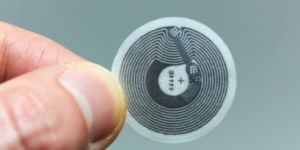RFID Readers: The Versatility of Handheld RFID Readers
Handheld RFID readers are portable, self-contained systems that seamlessly use radiofrequency signals to interact with RFID tags. They read their unique ID (UID) and transmit that data to central management systems.
Position-aware readers are invaluable tools when working in spaces where fixed readers may not be suitable, while their mobility can extend RFID applications beyond warehouse environments.
Versatility
 RFID tags have many uses beyond inventory management and supply chain optimisation; in particular, they increase product traceability, expedite order fulfilment, reduce theft and enhance security. The key to these advantages lies in handheld RFID readers that enable real-time data capture that bridge the gap between warehouse operations and field applications.
RFID tags have many uses beyond inventory management and supply chain optimisation; in particular, they increase product traceability, expedite order fulfilment, reduce theft and enhance security. The key to these advantages lies in handheld RFID readers that enable real-time data capture that bridge the gap between warehouse operations and field applications.
When an operator waves an RFID reader over assets tagged with RFID tags, the reader automatically detects and reads their UIDs – either visually displaying this data on its screen or alerting the user via audio that each tag was successfully read.
Wholesale handheld RFID readers come equipped with Bluetooth, Wi-Fi or cellular connectivity that enables seamless integration with backend systems and data transmission without issue. Furthermore, they can be tailored to support different RFID tag formats and 2D barcode scanning capabilities – making them a valuable asset in managing inventory and documents simultaneously. Their ease of use makes these readers an attractive option for business environments.
Inventory Management
RFID’s accuracy allows businesses to avoid human errors that arise with manual scanning or logging of inventory levels, providing real-time updates on inventory levels for improved decision-making and order fulfilment. RFID allows organisations to avoid overstocking or understocking costs and reduce labour costs while improving customer satisfaction, ultimately saving money and resources.
Many handheld RFID readers, more commonly called gun-style readers, combine barcode and RFID reading capabilities into a single device for workers’ inventory tasks. Some even feature writing capability so users can update information stored on pre-encoded tags. This feature can be particularly beneficial when transitioning between production stages; its RFID tag may need to be updated. Manufacturing processes requiring frequent checks to ensure quality control and industry compliance can benefit significantly from having employees who can scan barcodes and RFID tags take inventory of a warehouse or storeroom, searching for hard-to-find items rapidly.
Product Traceability
Handheld RFID readers speed up data collection and provide more accurate inventory management data. Furthermore, handhelds can read RFID tags at greater distances, typically up to several meters. Different antenna polarisations enable RFID readers to reach various distances depending on the tag’s position, bonding or attachment methods.
Product traceability refers to tracking and identifying every component that goes into making a finished product, from raw materials through distribution. This practice is essential for businesses that must uphold high standards while meeting regulatory compliance regulations; traceability allows swift identification and correction in case of recalls or recall issues.
Wholesale handheld RFID readers can help simplify supply chain processes, increase productivity and elevate customer satisfaction. By eliminating manual inventory counts and freeing employees to focus on tasks that add more value than counting products manually, RFID readers help facilitate seamless supply chains that result in superior customer experiences.
Security
handheld RFID readers offer more versatility than barcode scanners in terms of scanning products from any direction without being directly in sight of tags, making them particularly suitable for inventory tracking in warehouses and providing fast and convenient methods to check boxes before shipping merchandise out to customers.
Handheld RFID readers use a weak radio signal to activate RFID tags and expose their embedded information. Once activated, these tags respond with unique identifiers, and product data is transmitted back to the reader or centralised RFID management system.
A handheld RFID scanner is a small device equipped with an RFID reader and a display, which allows operators to interact with the data in real-time. Batteries usually power it and use a specific frequency range to scan tags in the vicinity. Depending on the model, handheld scanners may be able to read both high-frequency (HF) and ultra-high-frequency (UHF) tags. They can also be integrated with smartphones or tablets to enable wireless connectivity and data synchronisation.
You May Also Like

Wildlife and Fisheries Resources Program
August 4, 2019
The Forest Resources Management Program
August 28, 2021
